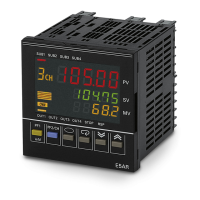2-4
Functions Supported Only by the E5AR/ER-DRT Section 2-2
Operating
Procedures
Setting Operation
Setting Parameters
The number of words allocated will depend on the E5AR/ER-DRT communi-
cations data allocations. The following points are important when setting node
addresses or allocating I/O memory.
• Do not allocate the same words to other slaves.
• Make sure the I/O area does not exceed the valid range.
2-2 Functions Supported Only by the E5AR/ER-DRT
A Configurator is used to make settings for the network power monitor func-
tion, accumulated ON (RUN) time monitor function, and control at error func-
tion.
2-2-1 Network Power Monitor Function
The E5AR/ER-DRT has a network power monitor function that turns ON the
Communications Power Voltage Monitor Error Flag in the General Status
when the communications power voltage drops below the set monitor value.
The monitor value for the network power voltage is set using the Configurator
and is found in the General Setting parameter group.
Power ON
RUN level Adjustment
level
Adjustment 2
level
Bank setting
level
l.bnk
PID setting
level
Approximation
setting
level
L Key: Less than 1 s
Input initial
setting
level
l.1
Alarm setting
level
l.3
Display
adjustment
level
l.4
Communications
setting
level
l.5
L Key: Less than 1 s
25. 0
0. 0
Control stops.
l.0
Control initial
setting
level
l.adj l.ad2 l.tecl.pid
Control initial
setting 2
level
l.2
Control ON
Control OFF
L
Key
Less than 1 s
L
Key
Less than 1 s
L
Key
Less than 1 s
L
Key
Less than 1 s
L
Key
Less than 1 s
0. 0
L
Key
Less than 1 s
L
Key
Less than 1 s
L
Key
Less than 1 s
L
Key
Less than 1 s
L
Key
Less than 1 s
L Key
At least 1 s
L Key
At least 3 s
Press the LEVEL Key for at least 3 s to move from the RUN level to the
input initial setting level.
Press the LEVEL Key several times to move from the input initial setting
level to the communications setting level.
The communications unit number (u-no) (DeviceNet node address)
will be displayed.
Press the UP and DOWN Keys to change the setting.

